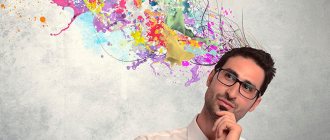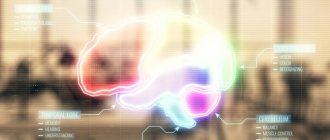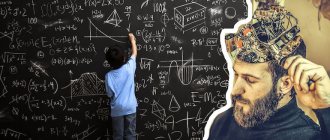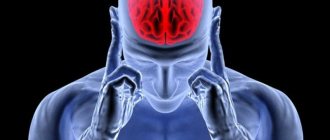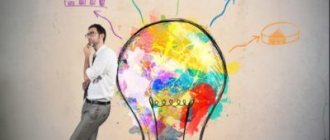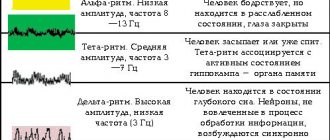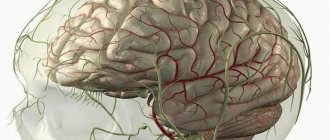A stroke is a serious pathology, since it always entails various disturbances in the functioning of the body, up to complete loss of legal capacity. Therefore, it is extremely important to promptly diagnose a right hemisphere stroke and prescribe adequate treatment and rehabilitation procedures. Only in this case can the lost functions be restored.
Neurologists at the Yusupov Hospital provide medical care to patients of any severity. The high professionalism of the doctors allows us to put back on their feet even those patients who were abandoned by doctors at other medical centers. >
The mystery of the cerebral hemispheres
Mysteries of the brain: the mystery of the two hemispheres
Our time is an era of amazing discoveries: deciphering the genome, cloning, organ transplantation... But the highest mystery of nature still remains the human brain.
brain, self-knowledge
Our time is an era of amazing discoveries: genome decoding, cloning, organ transplantation. But back in the 30s of the last century, Academician I.P. Pavlov noticed: the progress of natural science for the first time noticeably stopped in front of the highest mystery of nature - the thinking brain. Cybernetics called the brain a black box. We know what information enters the brain, and we can judge how this responds to a person’s behavior, thoughts and feelings. But what's going on inside - in this box?..
The brain has two hemispheres: left and right. But they developed at different times: for millions of years people lived only with the right hemisphere, and then another one appeared, which complicated the picture. It turned out that these two hemispheres are completely autonomous. They “speak” different languages and, as a rule, do not hear each other.
University of California scientist Robert Ornstein has proven that if the “weaker” hemisphere is stimulated and involved in work together with the “stronger” (leading), the effectiveness of human activity increases by 5-10 times.
Speech
The left hemisphere is verbal, it contains the center of speech, therefore left-hemisphere people are talkative. Ask me anything on a topic that interests me, and in a couple of minutes you will regret it. But at the same time, the right hemisphere is responsible for the emotional coloring of speech and intonation. In this vein, it is interesting to remember this. Owners of cats or dogs know that if you call your pet a bad word but affectionately, he will think that you are praising him. And why? Because there is no speech, but he picks up intonations. If the same is done to a person, he will be somewhat confused.
Verbal-nonverbal hemispheres are ambiguous. The left hemisphere is activated when reading scientific texts, and the right hemisphere is activated when reading literary texts. The right hemisphere is sensitive to humor and understands metaphors. (2) I am left-brained, so my metaphors are like oil spilled on the sea.
Left hemisphere: tasks
The left hemisphere is primarily concerned with processing, analysis and deduction; convergent (“converging” - from the general to the specific) thinking; facts, figures; the end result; structure, logic and consistency; mathematical models; expediency; reducing tasks to working details; science and technology; using a sequential approach - approaching step by step; verbal (verbal), literal, concrete language; developing well-defined plans; in order.
Right hemisphere: tasks
The right hemisphere is more “interested” in abstract topics; artistic expression; constructive tasks; ideas, emotions and feelings; creative crafts; divergent (“divergent” - from the particular to the general), global thinking; a process, not a result; using experience; knowledge through images; perception; prayer, meditation, mysticism; remembering faces; spontaneity; visual; working with symbols, fantasies, dreams, metaphors and images; working with the opposite and the unknown.
The two hemispheres of the brain are connected by a small area called the corpus callosum. Through it, the hemispheres “communicate” with each other, which largely determines coordinated and consistent thinking, imagination and human behavior. If this part of the brain is damaged, a person experiences mental and behavioral disorders.
Perception and creativity
1.7. It is not the hemisphere that dominates, but the function
So, the asymmetry of the hemispheres of the human brain is indisputable, the dominance of the left hemisphere in most people has been established, and the set of capabilities and functions of each hemisphere has been determined.
In these common statements lies the misconception. A fundamental clarification is necessary: it is not the structure of the hemispheres that is asymmetrical, but their functions! “The elementary unit (carrier) of asymmetry is not an organ, but a function” (V. Geodakyan).
It has been established that two types of thinking are associated with the left and right hemispheres of humans, respectively: abstract-logical and spatial-figurative. These types of thinking have a number of synonyms: verbal and non-verbal (since abstract-logical thinking, unlike figurative thinking, is based on the ability to produce speech); analytical and synthetic (since with the help of logical thinking the analysis of objects and phenomena is carried out, while figurative thinking ensures the integrity of perception); discrete and simultaneous (since with the help of logical thinking a number of sequential operations are carried out, while imaginative thinking has the ability to simultaneously perceive and evaluate an object).
Researchers have not yet sufficiently studied the question of whether there are reverse situations when the functions of the right hemisphere are performed by the left and vice versa. The general answer is probably no, although there is evidence of partial “function exchange” in certain situations and limits. As for motor functions, their “movement” sometimes happens. This may be an innate property or acquired. For example, 15% of left-handed people find the speech center localized in the right hemisphere.
Some functions can develop compensatoryly in an atypical hemisphere in non-standard situations: illness, injury, congenital developmental anomalies. The brain is a flexible, mobile structure with a high level of adaptability. But not absolute. In early life, the brain has enormous compensation capabilities. In children, the interchangeability of the hemispheres in terms of functions is much higher than in adults. For example, removal of the left hemisphere cortex for cancer in adult patients leads to severe irreversible speech loss. However, if such an operation was performed in infancy, it had almost no effect on speech development. With age, the plasticity of the brain organization decreases. Older children who had surgery on the left hemisphere could speak, but made many grammatical errors and understood speech less well.
Today it is believed that the right hemisphere of all people has more ancient abilities, more quickly, intuitively. The left hemisphere of all people is logical, has newer skills in evolutionary terms, and is slower.
It is important to note that a specific type of hemispheric response is not given to an individual at birth. Of course, left-hemisphere dominance is evolutionarily fixed. But not harshly. Rather, we can talk about a species predisposition. The contribution of each hemisphere depends on the task at hand. The left-hemisphere contribution to thinking, formed for interaction with other people, has become the most important component of inner life, because personality does not exist without social interaction.
Authorities in the field of neuropsychology are inclined to the following typology: one quarter of people (25%) have an absolute predominance of the left hemisphere, slightly more than one third (35%) have a pronounced dominance of the left, a little less than one third (30%) have approximately the same activity of the hemispheres (mixed type), the remaining one tenth (10%) is the predominance of the right hemisphere. Representatives of the mentioned mixed type are called ambidextrous (both hands are equally developed, that is, “both right”). Why hands? Because many researchers still equate handedness and hemisphericity, but this is not the same thing!
It is the type of task that plays the role of the main factor that selectively activates the brain structures of one or another hemisphere (detection, recognition, identification, comparison). Scientists believe that in the first stages of ontogenesis there is a continuous figurative accumulation of information about the world for its further detailing into discrete images and schemes. In the process of evolution and with the development of civilizations, humans increasingly needed the functions of the left hemisphere. Today, the functions of the left are more needed than the right, which is why most people on earth are left-hemisphere. A small child does not have a clear, constant dominance of the hemispheres. Their role changes depending on the periods of development. In the early stages of ontogenesis, the majority of children who do not receive special developmental activities at home or in the studio exhibit a figurative, right-hemisphere type of response. But starting from the age of 5-7, children are presented with “left-hemisphere demands” both at home and at school. They very quickly understand what adults want from them. And adults want obedience (orderliness), prudence (logic), and submission to the rules of society (conventionality). And at the age of 10-14 years, one or another phenotype is fixed, mainly characteristic of a given population.
The entire education system in the world today is based on left-hemisphere methods of perception - speech, recognition, orderliness, logic, analysis. Right hemisphere functions are not in demand, therefore they are in recessive. This is also confirmed by the data that illiterate people have less functional asymmetry of the brain than literate people.
But we must not forget an important thing - it is not the hemisphere that dominates, but the function!
Throughout life, the specialization of functions increases and is consolidated by demanded experience. Both hemispheres are involved in a single act of thinking and behavior - always and in a friendly manner, complementing each other in a complex way. This is not a simple summation of their capabilities, but a systemic simultaneous process that science has yet to study.
For example, when we talk about the dominance of the right hemisphere in a given individual, we must keep in mind that it is not the hemisphere itself that dominates (that is, it works better and more, performs its functions better and faster, is anatomically more perfect, and the left one is less developed), but its functions . That is, for some reason they prevail in the period under review. And if you constantly use the functions of the right hemisphere, they will be performed more and more accurately and faster. It is obvious. And if, in parallel, the functions of the left hemisphere (concordant inhibition) are used little and rarely, then it will remain slow and undeveloped.
Often, hemispheric dominance changes throughout the life of one individual. It depends on the requirements of his life conditions, on circumstances and even on his desire. For example, a person was engaged in logical work. I became interested in drawing and began to train my right hemisphere through these activities, without realizing it. Five years later, his right was dominant. Although this does not mean that it has become more developed than the left. Since the hemispheres perform different functions (sometimes completely different), it is not legal to compare them in a strict sense at all!
Today in our civilization more functions of the left hemisphere are in demand. In addition, emerging new ones also appear in the left. So how can he not dominate! His work is in great demand. And the capabilities of the right are underutilized. So it is in subordination.
As long as a left-hemisphere person is in familiar society, he is optimally integrated and prosperous. As soon as he finds himself in non-standard conditions, where the functions of the left hemisphere are almost useless, his vitality drops sharply. The native New Yorker is well versed in the concrete jungle and how it works. Let's take it to the natural jungle: the thicket of the forest, wild animals, the problem of self-preservation, food, housing. All accumulated skills, life patterns, logic and analysis are useless here. Suddenly there is a need for the functions of the right hemisphere - synthesis (independent invention of a method of survival), orientation, instant assessment, multifactorial, intuition, etc. At first, the brain will be in fear and confusion. But after some time, the right hemisphere will “develop”, its functions will become dominant, and the functions of the left will go recessive (“underground”).
The opposite experiment was carried out in America. Five people from a wild tribe in Africa were taken to different states. They were in the metropolis, in apartments, on the farm of a private farmer. To be fair, it should be noted that the people from the tribe were not completely wild (there are practically no such people left on Earth). But in their entire lives they never left their lands, lived in the forest, were engaged in hunting and, little by little, cattle breeding, and had no education in our understanding. For these reasons, it can be assumed that the right hemisphere dominates in representatives of such a population, especially since adaptation to new conditions occurred quickly and painlessly, as befits right-hemisphere people. And indeed, it was interesting to watch their reactions. They didn’t dwell on details, they didn’t care about clothes, gadgets and other nonsense. But they were sincerely surprised why there were so many people in a bad, smelly and stuffy place like a metropolis. They sincerely wondered why the farmer was upset that he had few livestock and could not cope well with the competition. They threw up their hands and said: “He has large herds, pastures, a house, but he is unhappy and complains. We have few cows and no pastures at all, but we are happy.” This is the multi-contextual view of the right hemisphere, this is its independence of thinking and lack of conventionality.
The interhemispheric asymmetry of mental processes is individual for each civilized person. Therefore, it makes sense to talk only about the reliable predominance of certain traits. In this regard, experts have introduced such a concept as “individual asymmetry profile”, or “individual lateral profile”, or “profile-lateral organization”. These parameters, among many other factors, determine the quality of human activity, and they are also used for practical purposes. In many professions, they are seriously taken into account when hiring (pilots, dispatchers).
It may seem that “left-brain” people are smarter than “right-brain” people. But this is only at first glance. It’s just that the more researched functions of the left sections are easier for us, “left-hemisphere” people, to understand. For this reason, they, in fact, have been better studied. It is easier to “measure” them, to convey them with quantitative characteristics. How can one explore, for example, the depth of intuition that “lives” in the right hemisphere? How to measure the ability to perceive the ambiguity of phenomena? The functions of the right hemisphere are qualitatively different, they are organized more complexly and differently, they complement and deepen the picture of the world created by the left hemisphere, and they combine individual blocks of information into a holistic picture.
It would be more true to talk about the dominance of the hemispheres by function. And since in our civilization today the functions of the left hemisphere are more in demand, and they are “more noticeable,” it seems that the left hemisphere dominates totally. But if we look at the work of the brain in areas where the functions of the right hemisphere are more in demand (the area of intuition and feelings, social work with disadvantaged sections of the population, creative practices, fine arts, theater, cinema, design, scientific creativity, invention), then, undoubtedly, the right will be recognized as dominant. And this too will seem total.
There is an opinion that “right-brained” is synonymous with giftedness. Many people seriously believe that all “right-hemisphere” people are entirely geniuses, at least potential ones. Let's be clear. We are talking only about the comparative development of the cerebral hemispheres. In one person, both of them may be poorly developed, but the right one is much more developed. And such an individual, being “right-brained,” will be an ordinary person with no prospects for creative growth. In addition, since in modern life the functions of the left hemisphere are more in demand, the right hemisphere is looked at in these circumstances as “worthless”, “stupid”, “unreliable”, “not adapted”.
But people stubbornly consider left-handedness to be a sign of talent. Any person would like to be different from others in a favorable way. It pleases the ego. In 1992, the holiday International Left-Handers Day was even invented, celebrated on August 13th. There are approximately five hundred million left-handers in the world (one in ten). These data are approximate, since left-handers can be hidden, overtrained, or incomplete. In our country, almost no one knows about Lefty Day. But everyone knows N. S. Leskov’s tale about Lefty, who shoed a flea. This is a mythologized image of a Russian craftsman, emotional, creative, attached to his native land, reckless and selfless in the Russian way. Why is he left-handed? To enhance the artistic image, since it is more difficult to work with the left hand, everyone knows this. And Lefty, if you remember, also had a scythe. With such and such data, even shoeing a flea is heroism!
Let us repeat that the localization of functions is the same in all people. All people have logic, abstract thinking, and analytical abilities on the left. All people on the right “place” intuition, figurative and polysemantic perception, spatially specific thinking, abilities for synthesis, music, singing, creativity, and finally. The function cannot move from one hemisphere to the other! It can only be more developed, less developed, overdeveloped or underdeveloped.
Briefly about the same
“The elementary unit (carrier) of asymmetry is not an organ, but a function” (V. Geodakyan). The localization of functions is the same for all people. In humans, two types of thinking are associated with the left and right hemispheres, respectively: abstract-logical and spatial-imaginative. One quarter of people (25%) have an absolute predominance of the left hemisphere, slightly more than one third (35%) have a pronounced dominance of the left, a little less than one third (30%) have approximately the same activity of the hemispheres (mixed type), the remaining one tenth (10%) ) - predominance of the right hemisphere. Although left-hemispheric dominance is evolutionarily fixed, a specific type of hemispheric response is formed throughout life.
The entire education system in the world today is based on left-hemisphere methods of perception - speech, recognition, orderliness, logic, analysis. The right hemisphere functions are not in demand, therefore they are in a depressed state. A civilized citizen is left-hemisphere and adapted to left-hemisphere reality. But if he finds himself in a natural wild environment, he turns out to be helpless. On the contrary, representatives of wild tribes are perfectly adapted to life in the wild due to the activity of the right hemisphere and are completely lost in the conventions of the modern city. The natural environment requires the functions of the right hemisphere, and it becomes dominant.
Interhemispheric dominance is extremely plastic, especially in children. Over the course of life, the specialization of the functions of the hemispheres increases and is reinforced by relevant experiences. At the same time, the asymmetry of mental processes in each civilized person is individual and can change throughout life, but within relative limits.
If the right hemisphere is dominant
Someone who solves problems using the right hemisphere:
- softens rational thought with emotional and intuitive preferences;
- uses various methods of “bringing” extraconscious material into understanding;
- avoids censorship of ideas during their “maturation”;
- considers divergent, even contradictory, ideas with respect rather than with skepticism and defensiveness;
- tries not to neglect intuition;
- tests any rational way of solving a problem to see if it feels intuitively good during the development process and in the final solution;
- tries to remain constantly aware of himself.
Characteristics of right-hemisphere thinking
A person whose right-hemisphere thinking predominates often uses an intuitive approach to solving life problems and professional tasks. Such a person uses logic in situations of extreme necessity. For a right-brain person, high ideals and moral guidelines are valuable; he is inclined to philosophize. The “artist” does not like it when someone controls him: he prefers to act on his own initiative. For a right-brain person, relationships with others are important. Such a person is capable of generating unique ideas, creating something new and beautiful.
It must be said that the classical education system is designed to develop predominantly left-hemisphere thinking, almost completely ignoring the development of right-hemisphere skills. This is expressed in the fact that children and students are taught only to memorize and reproduce information within the framework of the curriculum, at most to think logically, and very little attention is paid to the development of imaginative thinking, imagination, fantasy, intuition, and creativity. Unfortunately, right-brain, creative thinking is not cultivated in traditional educational institutions and, as a result, students become ordinary “standard” adults. This approach significantly limits the process of personality development and makes it one-sided.
Understand each other
The result is that the two hemispheres live in different realities and express themselves in completely different ways. For example, the lecturer builds certain logical connections and strings together concepts. But not everyone in the audience understands him, and then he names a certain metaphor and sees that some of the listeners grab a pen to write down an image they understand.
Some people find it difficult to think, reason, and comprehend logical connections. They talk about their problems and, when you manage to understand the reason for their condition, they are sincerely surprised: “Why has this never occurred to me?” Other people are bad with emotions. They do not understand why feelings are needed, and often even despise mental anguish.
In one of the sciences that understand the mystery of the brain - neuropsychology - it is customary to talk about the dominance of one of the cerebral hemispheres and the so-called interhemispheric asymmetry. This asymmetry is normal. It is believed that in men the left hemisphere of the brain is predominant - dominant, and in women - the right hemisphere of the brain.
How to “wake up” the second hemisphere: exercises
The hemisphere that you usually don't use can be "awakened." This can be done with simple exercises.
Mirror and asymmetrical drawing
Take a blank sheet of paper and two pencils, one in each hand. Draw mirror-symmetrical designs and letters with both hands at the same time. When this comes easy to you, you can complicate the task - draw asymmetrically: one hand, for example, draws a square, and the other at the same time draws a star.
"Ear-nose"
With our left hand we take the tip of the nose, and with our right hand we take the opposite ear, i.e. left. Next, clap your hands, and then change the position of your hands. Over time, you can increase the pace.
"Captain"
This exercise is similar to “ear-nose”, only the gestures change. You need to put one hand to the “cap”, and show “class” with the other hand.
Perfect balance?
So what then can be considered a psychological norm? Someone may answer right away: equilibrium, balanced development of both hemispheres. But how can this be achieved and what will human culture look like in this case? It's hard to imagine. Perhaps it will not contain outstanding discoveries and creations, but will something qualitatively new arise? This encourages us to continue to think about the mysteries of the brain.
Author: Pavel Gurevich, Doctor of Philological and Philosophical Sciences, Professor
The material used photographs belonging to shutterstock.com
Why develop right-brain thinking?
Many scientists have emphasized the special value of right-hemisphere thinking. One of the founders of scientific pedagogy, the German researcher Johann Friedrich Herbart noted that a bad teacher presents the truth, while a good teacher teaches to find it. Neuropedagogist Natalia Traugott said that “the educational system needs to be warned against left-hemisphere education, as this produces people who will not be able to carry out real actions in real situations.” Professor T. P. Khrizman lamented that “right-hemisphere people—generators of ideas—are disappearing. The question is serious: we need to save the nation.”
“An experiment in the field of pedagogy and psychology conducted by American, Swiss and Austrian scientists showed that schoolchildren began to excel significantly in all disciplines when the regular school curriculum was reduced by increasing the hours of music lessons.”
Recently, the issue of intensive development of right-hemisphere thinking has become topical. For example, the ability to think imaginatively and comprehensively, and quickly generate ideas are the most important skills of a modern top manager, who often works in conditions of chaos and stress. The largest companies - banks, retailers, manufacturers - do not neglect the development of intuitive-sensory thinking of their employees, including management. Therefore, right-brain thinking should be developed in order to succeed and improve the quality of life.

